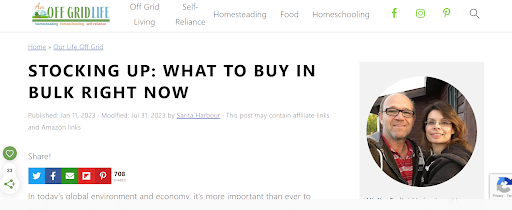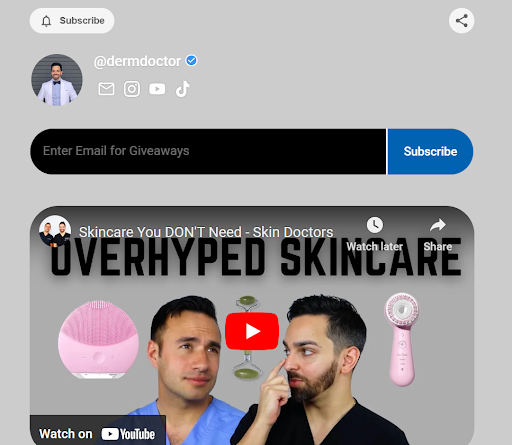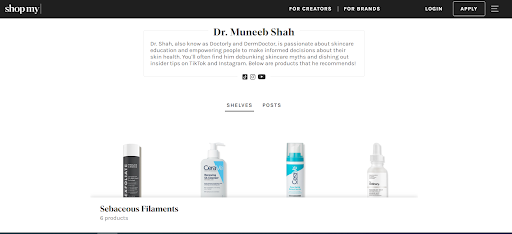18 Types of Content That Affiliate Marketers Can Use (With Examples)

Remember way back when salesmen used to go door-to-door? That was the pre-digital version of affiliate marketing.
Like today’s affiliate marketers, salesmen in times past received a commission on every product sold. But unlike old-fashioned selling, affiliate marketers are a lot more efficient, and the income potential is unlimited, thanks to all the technology they now have access to.
The best affiliate marketers know they won’t get far if they try to sell to everyone; instead, they invest time and effort in identifying potential customers and then creating customized marketing funnels targeted specifically to them. And perhaps the most important tool they use to build those funnels and drive conversions is content.
Want to discover the best types of content for affiliate marketing? Keep reading.
Content for Affiliate Marketers: A Complete List
There’s no “secret sauce” when it comes to affiliate content marketing. What works for one affiliate marketer might not for another.
Luckily though, there are many different types of content you can use to craft successful affiliate campaigns. The two factors of success that all marketers agree on are quality and frequency. If you curate loads of great content and publish it in the right places, sales will follow.
Here’s a list of all the content types that affiliate marketers rely on to boost their commissions:
1. Blog posts
As an affiliate marketer, it is highly likely you already have an active blog. If you are just starting out with affiliate marketing, now is the time to launch one. Blog posts can take the form of informative or entertaining articles about topics relevant to the product or niche, driving engagement and interest in your offering.
Crucially, blogging increases affiliate income potential by helping you gain audience trust. When people trust your expertise, knowledge, and opinion, they are likely to follow your recommendations. Over at “An Off Grid Life” blog, homesteader Sarita Harbour and family provide a wealth of content about homesteading, homeschooling, and more, full of affiliate links where readers can purchase relevant products.

2. Product reviews
Product reviews are a cornerstone of affiliate content marketing, providing a platform for affiliate marketers to communicate their experiences and opinions about a particular product or service. Reviews establish credibility and trust by sharing firsthand knowledge and honest opinions. Product reviews should include a compelling analysis of features and benefits, with the ultimate aim of converting readers to buyers. It’s important to be authentic and that means discussing the drawbacks of the product too.
Product reviews are also important for SEO strategy, attracting organic traffic from users searching for similar products. Make sure to embed affiliate links strategically in product reviews, making the path to conversion as easy as possible.
Check out this example of an affiliate product review. Ironically, the marketer is reviewing the Temu shopping app, and linking to her Amazon affiliate offers.
3. Videos
With more than 2.7 billion monthly users, YouTube is not only the largest video platform but also a highly profitable channel for affiliate marketing. Just like written content, marketers use videos to direct traffic to relevant landing pages, product pages, and seller websites.
For example, KarenBritChik is a popular fashion vlogger who uses videos to engage interested audiences and drive viewers to affiliate links for featured products. Check out the description for one of her YouTube videos; note the affiliate links for “Items in this video” and “Shop my closet” embedded in the description.

4. Comparison articles/videos
Consumers today are faced with millions of choices. Content that compares the affiliate product to similar offerings is a great way to help them understand the differences and make an informed decision.
You may think that comparison articles are risky; after all, the audience might choose a product besides the one you are promoting. However, the opposite is true. By publishing honest and transparent comparison articles and videos, affiliate marketers can earn trust among audiences, which is essential to any kind of sales success.
In any case, an honest review will provide both sides of the story, and what is a drawback to one customer could be a strong selling point to another. As the adage goes, honesty is always the best policy, also in affiliate marketing. Check out this example of what an effective comparison article looks like.
5. Tutorials and how-to guides
Tutorials and how-to guides provide audiences with practical insights and step-by-step instructions, demonstrating how a product or service can address users’ needs. By showcasing how to use and enjoy the product, affiliate marketers establish themselves as knowledgeable experts. And of course, these tutorials not only educate users but also seamlessly integrate affiliate links, enhancing the potential for conversions while offering genuine value to the audience.
Tutorials and how-to guides can come in a range of formats – educational videos, written manuals, step-by-step instructions, and more.
6. Listicles
Affiliate marketing listicles are curated lists of top products within a specific niche. Listicles can include affiliate links for all the products in the list, or may prominently feature a particular affiliate product alongside other options.
Listicles are a great way to capture the audience’s attention with an easily digestible and entertaining content format. An advantage of using listicle-styled content is the range of affiliate products they offer, catering to a wider range of preferences among the audience. Listicles are also highly shareable, increasing reach and opportunities for conversion. Strategic placement of affiliate links within the list or in the description for video listicles is of course essential.
7. Case studies
Case studies are a content format of choice for B2B affiliate marketers. Real-world examples and success stories that illustrate how the affiliate product solved a problem or delivered benefits are some of the most effective ways to drive engagement and conversions.
Case studies offer potential customers tangible evidence of the benefits and value a product can bring. Sharing stories of how affiliates themselves have experienced positive results builds trust and credibility. Case studies also address potential concerns or doubts, enhancing trust and helping bring buyers closer to a purchase decision.
Take a look at this sensational Shopify case study, and note the affiliate link to sign up for Shopify in the video description.
8. Email campaigns
Email is one of the ‘oldest’ digital marketing channels, but it is still a winner – if you know how to do it right.
Many affiliate marketers employ email marketing to earn money. By convincing people online to provide their email addresses, marketers can build email lists that they can use for targeted campaigns. Promoting a product or service to those who have already expressed interest in similar items increases the chances of conversion via a follow-up email.
For example, a user downloads an e-book titled “The Ultimate Guide to Video Marketing,” provides their email address, and agrees to receive emails regarding similar offers. The affiliate marketer can assume the user is interested in learning about or using video marketing. This allows them to customize offers to send to this particular person in the future, based on this previously expressed interest.
9. Infographics
Infographics condense complex information into visually appealing formats. These eye-catching graphics do a great job of capturing attention and conveying key product details efficiently. By presenting relevant information in a concise and engaging manner, infographics help increase the audience’s understanding and knowledge of the product, bringing them closer to purchase decisions.
Infographics are highly shareable, so they are also a good way to expand audience reach on social media. Smart placement of affiliate links within the design guides readers toward conversion. The ability to simplify concepts and attract audiences makes infographics a powerful tool to boost engagement and conversions in affiliate marketing campaigns.
10. Social media posts
Social media posts enable affiliates to reach and engage a vast audience on social networks such as Facebook, Instagram, Twitter, LinkedIn, TikTok, Snap, and more. Social media posts that highlight product benefits and solutions are one of the most accessible ways for affiliates to captivate users’ interest. Sharing personal experiences, tutorials, or reviews can establish authenticity and build relationships with viewers.
With nearly 5 billion people worldwide on social media, affiliate marketers must leverage these platforms to build a presence, gain a following, and promote affiliate products and links. Well-executed social media posts, including text, video, images, or GIFs, enhance visibility, engagement, and conversions, making them indispensable for affiliate content marketing campaigns.

11. Webinars
Webinars provide an interactive platform where affiliates can host live sessions to discuss industry trends, share insights, and present products or services. Webinars are a powerful way to engage and educate audiences, helping affiliates position themselves as authorities in their niche and build direct relationships with audience members.
During the webinar, the host introduces affiliate offerings that are relevant to the topic being discussed. Via Q&A sessions and discussions, webinars help strengthen the personal connection with audiences. The recorded sessions can later serve as evergreen content, continually driving traffic and conversions. By blending education and promotion, webinars are an effective type of content to amplify affiliate marketing efforts.
Here’s an example of a webinar by Career Foundry with special guest Alex the Analyst about how to use ChatGPT for analytics. In the video description, Alex provides an affiliate link to enroll for Career Foundry’s Data Analytics program and receive a big discount. This is a perfect example of a webinar recording that drives affiliate income.

12. Podcasts
Podcasts are a form of audio content where affiliate products can be injected naturally into the conversation, including their pros and cons, real-world experiences, and potential uses. Podcasters can bring in experts in the niche to engage audiences on relevant topics around the affiliate products and offer special discounts or deals for listeners.
Podcasts are a great way to establish rapport with potential customers, particularly those who prefer consuming content in an audio format. They are also an effective tool to build a presence as an industry authority, providing new perspectives and insights. For example, the Smart Passive Income podcast by Pat Flynn integrates affiliate offers, showcasing the value of relevant tools and services within the context of the podcast content.
13. Interviews
Creating a constant stream of good-quality content is hard, but it’s what affiliate marketers must do to succeed. One of the ways to shake things up a little, add new flavor to the mix, and provide fresh angles is by conducting interviews with personalities who are in some way connected or relevant to the product, industry, or topics around it.
Conversations with experts or users who share their experiences with the affiliate product are not just engaging; they also enhance its credibility. Discussion about different pain points or issues in the industry or niche creates interest and enthusiasm among the target audience, which can lead to higher clicks and conversions. Interviews can be conducted on YouTube videos, live social media broadcasts, or podcasts. They can also be transcribed into text format for blogs and sprinkled with affiliate links. The key to a great interview of course is great conversation, so choose your interviewees carefully.
14. E-books
E-books are in-depth, downloadable guides that provide comprehensive insights into a particular niche, with the affiliate product being recommended within the content. E-books are a popular tactic for B2B affiliate marketing, for a few reasons. First, B2B pain points and products tend to be more complex and often require a deeper, more detailed discussion. Second, e-books are a good way to demonstrate unique knowledge and authority in the niche, which is very helpful in making an impression among professionals in the industry. Third, the longer format allows for in-depth exploration, catering to readers’ thirst for information. This approach not only establishes the affiliate as a valuable resource but also builds relationships with potential buyers, increasing the chance of conversions and boosting campaign results.
Well-written e-books are not only great for building authority and gaining audience trust; they are also awesome for creating leads. Promote an affiliate product in a great guide, and you’ll get paid every time someone purchases using your affiliate link or code.
E-books and guides are also some of the best ways to build email lists. By incentivizing users to sign up for your mailing list in exchange for an ebook, you can follow up later with email marketing.
15. Influencer collaborations
Influencer marketing is one of the most popular marketing tactics today, and affiliate marketers can use influencer collaborations to boost reach and conversions. Affiliate marketers often partner with influencers who are well-known in a relevant niche and who have a sizeable following that listens to their recommendations. This is a really effective way to tap into an already established and engaged audience.
Collaborations can take on many different forms, from video reviews and recommendations shared by the influencer on social media, blog posts published by the influencer on their website, or any other way to showcase the affiliate product to their followers. The influencer typically takes a cut from the affiliate income. However, a good collaboration with the right influencer can greatly expand the potential success of the affiliate campaign, which makes it worthwhile.

16. Landing pages
Landing pages are dedicated web pages designed and optimized for conversions, providing detailed information about the affiliate product and its benefits. More to the point, landing pages are opportunities to convert visitors into leads. However, many affiliates take the wrong approach and therefore don’t capitalize on them fully.
When it comes to creating a landing page, there is no one-size-fits-all approach. Every landing page, even if it is created by the same company or individual, needs to be customized according to the needs, interests, and behavior of the target audience, the niche or industry, and the affiliate offer. Take a look at these examples of effective landing pages, as well as recommendations for landing page builders to help you create landing pages for your affiliate campaigns.
17. Paid advertising
Running paid ads on platforms like Google Ads, search engine results pages, native networks, and social media is a key strategy to drive targeted traffic to affiliate product pages.
With Google Ads, affiliate marketers can bid on relevant keywords, ensuring their optimized landing pages appear prominently in search results. Native advertising on platforms like Outbrain integrates affiliate ads on high-quality websites, including news and entertainment sites, capturing relevant audiences when they spend time online. For example, an affiliate marketer promoting fitness products can advertise on health-related websites, directing traffic to the affiliate offer.
Unlike organic content, which is a longer-term strategy, paid ad campaigns require upfront investment. Yet with advanced targeting capabilities and the right strategy, affiliate marketers can use paid advertising channels to quickly boost traffic, attract quality leads, and increase the potential for conversions.
18. SEO-optimized content & guest posts
SEO-optimized content is a must for successful affiliate marketing campaigns. Creating content that ranks well in search engines boosts online visibility and helps attract organic traffic and potential buyers. Affiliate marketers should spend solid time researching and incorporating relevant keywords in blog posts and other SEO content, ensuring their content ranks higher in search engine results. Once the audience lands on the content, it is vital that it be high-quality and informative, so they stay engaged and build interest in the affiliate product or offer.
Remember to add keyword-rich content to optimize pages for SEO – for instance, including a short FAQ section at the bottom of the page is an effective way to add more keywords and enhance relevance on search engines. With affiliate links integrated naturally into the content, readers are given opportunities to purchase while their attention is focused on the page. It is also very important to update and optimize SEO content regularly, so it stays relevant and maintains its position in search rankings over time.
Guest posting is another useful SEO tactic for affiliate marketers. This is a good way to crosslink to other popular or authoritative personalities in the niche, gain exposure, and increase visibility and reach.
Here’s an example of an SEO-optimized web page for the long-tail keyword “best solo Vietnam travel itinerary”. It got top ranking on the SERP, and is peppered with affiliate partner links that no doubt perform well for this savvy affiliate marketer and travel aficionado.

How Can Affiliate Marketers Use All Types of Content?
So how does it all come together? Affiliate marketers can use a combination of content types to create marketing funnels and drive high-converting campaigns. Let’s take a look at how dermatologists Dr. Shah and Dr. Maxfield use content to educate their audience about healthy skincare and promote affiliate products to generate income.
First up, they co-host a collaborative YouTube channel called Doctorly, where they promote product review videos and educational content, integrating affiliate links for recommended products. Here’s an example:
Dr. Shah, who also goes by the moniker “Dermdoctor” has a link in bio with product recommendations and affiliate links to his online marketplace. Viewers can subscribe to keep up-to-date with product reviews and other information. It also features an email signup where the audience can register to receive giveaway promotions and join the email distribution list.

Of course, there is Dr. Shah’s online store, where visitors can enjoy relevant content and shop for skincare products via affiliate links.

Plus, take a look at an example of an Instagram post by the Doctorly duo, featuring a product review. Note that it is not officially affiliate content – the creators even specify in the description of the video that this is “NOT sponsored”. Using non-sponsored content is a great way to increase exposure, enhance audience trust, and reinforce the broader affiliate content strategy.

Affiliate Content Marketing – Do It Right
Affiliate content marketing is a mutually beneficial strategy – it not only helps marketers earn a handsome amount of income but is also highly useful for businesses to increase their customer base and revenue.
Depending on your target niche and audience, you can either use one, a few, or all of the content formats outlined above to promote affiliate products. Best of luck with all your affiliate marketing efforts!










![Best Affiliate Networks 2024 [Updated]: Tap Into the Earning Power of Affiliate Marketing](https://www.outbrain.com/blog/wp-content/uploads/2023/07/best-affiliate-networks.png)

